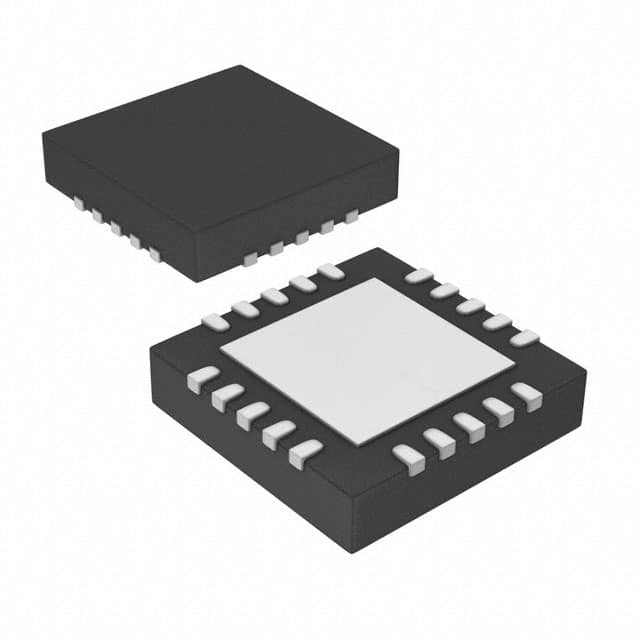Подробную информацию о продукте см. в характеристиках.

PIC16F1709-I/ML
Introduction
The PIC16F1709-I/ML is a microcontroller belonging to the PIC16 family of microcontrollers developed by Microchip Technology. This entry provides an overview of the product, including its category, use, characteristics, package, essence, packaging/quantity, specifications, detailed pin configuration, functional features, advantages and disadvantages, working principles, detailed application field plans, and alternative models.
Basic Information Overview
- Category: Microcontroller
- Use: The PIC16F1709-I/ML is used for embedded control applications in various electronic devices such as consumer electronics, automotive systems, industrial automation, and more.
- Characteristics: It features low power consumption, high performance, and versatile peripherals suitable for a wide range of applications.
- Package: The PIC16F1709-I/ML is available in a 20-pin QFN package.
- Essence: The essence of this microcontroller lies in its ability to provide efficient and reliable control in embedded systems.
- Packaging/Quantity: It is typically supplied in reels with a quantity specified by the manufacturer.
Specifications
The PIC16F1709-I/ML microcontroller offers the following key specifications: - High-performance RISC CPU - Flash program memory - EEPROM data memory - Analog-to-digital converter (ADC) - Enhanced Universal Synchronous Asynchronous Receiver Transmitter (EUSART) - Timers and PWM modules - Low-power features - Operating voltage range - Temperature range
Detailed Pin Configuration
The detailed pin configuration of the PIC16F1709-I/ML microcontroller includes the assignment of pins for power supply, input/output, communication interfaces, and other peripheral connections. Refer to the datasheet for the complete pinout details.
Functional Features
The functional features of the PIC16F1709-I/ML include: - Versatile digital and analog I/O capabilities - Integrated communication interfaces - Flexible and programmable peripherals - Low-power operation modes - Enhanced control and processing capabilities
Advantages and Disadvantages
Advantages
- Low power consumption
- High performance
- Versatile peripherals
- Compact package size
- Extensive development tools and support from Microchip Technology
Disadvantages
- Limited memory compared to higher-end microcontrollers
- Restricted processing capability for complex algorithms
Working Principles
The PIC16F1709-I/ML operates based on the principles of embedded control, utilizing its CPU, memory, and peripherals to execute programmed instructions and interact with external devices. It follows the standard operation of a RISC-based microcontroller, executing instructions fetched from its program memory.
Detailed Application Field Plans
The PIC16F1709-I/ML finds application in various fields, including: - Consumer electronics - Automotive systems - Industrial automation - Home appliances - Medical devices - IoT devices
Detailed and Complete Alternative Models
Alternative models to the PIC16F1709-I/ML include other members of the PIC16 family, such as the PIC16F171x series and PIC16F188xx series. These alternatives offer varying combinations of features, memory sizes, and peripheral sets, catering to different application requirements.
In conclusion, the PIC16F1709-I/ML microcontroller from Microchip Technology serves as a versatile and efficient solution for embedded control applications, offering a balance of performance, power efficiency, and peripheral integration. Its widespread use across diverse industries underscores its relevance and applicability in modern electronic systems.
Word count: 443
Перечислите 10 распространенных вопросов и ответов, связанных с применением PIC16F1709-I/ML в технических решениях.
What is the maximum operating frequency of PIC16F1709-I/ML?
- The maximum operating frequency of PIC16F1709-I/ML is 32 MHz.Can PIC16F1709-I/ML be used for motor control applications?
- Yes, PIC16F1709-I/ML can be used for motor control applications with its integrated peripherals and PWM capabilities.Does PIC16F1709-I/ML support analog-to-digital conversion?
- Yes, PIC16F1709-I/ML features a 10-bit ADC module for analog-to-digital conversion.What communication interfaces are supported by PIC16F1709-I/ML?
- PIC16F1709-I/ML supports SPI, I2C, and UART communication interfaces.Is PIC16F1709-I/ML suitable for battery-powered applications?
- Yes, PIC16F1709-I/ML is suitable for battery-powered applications due to its low power consumption features.Can PIC16F1709-I/ML be programmed using C language?
- Yes, PIC16F1709-I/ML can be programmed using the C language with MPLAB XC8 compiler.What are the available memory options in PIC16F1709-I/ML?
- PIC16F1709-I/ML offers flash program memory of up to 14 KB and SRAM of 1 KB.Does PIC16F1709-I/ML have built-in security features?
- Yes, PIC16F1709-I/ML provides various security features such as code protection and data EEPROM memory.Can PIC16F1709-I/ML operate in harsh environments?
- Yes, PIC16F1709-I/ML is designed to operate in harsh environments with its wide operating voltage range and robust design.Are there development tools available for PIC16F1709-I/ML?
- Yes, Microchip provides a range of development tools and software support for PIC16F1709-I/ML, including MPLAB X IDE and various hardware debuggers.

